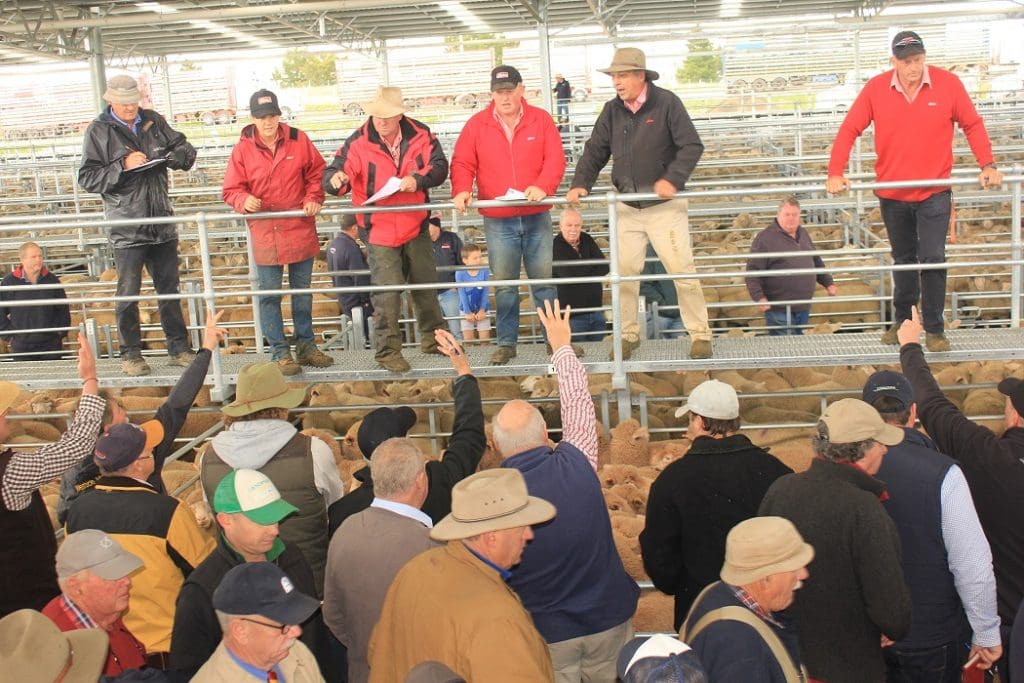
The Elders team selling lambs at the new Ballarat saleyards.
MAJOR Australian lamb processors have released forward lamb contracts as saleyard prices surge to levels four months earlier than they were achieved last year.
Late last month, as processors struggled to buy quality slaughter lambs with weight and finish, especially in New South Wales, rising saleyard lamb prices pushed the Meat & Livestock Australia’s eastern states trade and heavy lamb indicators over the 800c/kg mark.
After Thursday’s saleyard sales, the ES Trade Lamb Indicator closed up two cents to 829c/kg, 196 cents above its level a year ago and the heavy lamb indice finished up five cents to 825c/kg, 202 cents above its mark at this time in 2019.
Over-the-hook prices continue to trail behind the saleyard rates due to the strong competition for supplies, with OTH trade lamb prices available at 760-780c/kg, while saleyard values push more consistently over 800c/kg. One supermarket is also reportedly buying heavier lambs than its preferred grid requires to get quality and numbers.
Heavy shorn lambs are beginning to make $300-plus as export processors, and domestic processors compete for quality finished lambs for carcase and export-quality cut markets.
The main slaughter lamb indicators pushed above the 800-cent mark in May last year after staying below 700c/kg for the first three months and then rising quickly, with the ES trade lamb indicator almost reaching 900c/kg (889c/kg 31 May) by the end of May, while the heavy lamb mark hit 912 on May 29 before stabilising below 900 cents for weeks.
However, in what might be a portent for the months leading into winter 2020, the heavy lamb indicator hit 907c/kg by 18 June 2019 and surged higher to 950c/kg by 3 July, when the trade lamb indicator got to 902c/kg. Both indicators stayed above 900c/kg until the end of July.
After the quick rise in 2020 saleyard prices and in an effort to lock in forward supplies, JBS Australia has released a contact for 20-32kg cwt shorn lambs only of 750c/kg in March, 760-770c/kg in April and 780-800c/kg in May for delivery to Brooklyn and Bordertown. Lambs weighing 16-19kg and 32kg-plus will be discounted 50c/kg and all lambs delivered must be MSA-registered. Click here for full details.
The Coles contract is for March delivery to Gundagai, NSW, and to the Australian Lamb Company’s Colac plant in Victoria, of 18-26kg cwt lambs at 820c/kg, with a 50 percent upside if the Coles weekly spot grid price exceeds the contracted price. Click here for full details.
Saleyard and contract prices encouraging restockers
Delta Ag livestock manager and auctioneer at Wagga Wagga, Aaron Mackay, said the centre had consistently offered excellent quality lambs this year, but he thought there would have to be a shortage of good lambs in the north.
“The south has run out, they’ve done all their lambs, we’ve got weight here, and store lambs have got very very dear.”
He said restockers don’t want lambs under 35kg lwt, but were “all over like a rash” lambs in the 34-40kg lwt range.
“There were lambs that went back to the paddock yesterday (last week) at $210.
“They wouldn’t be going out for long, possibly for 2-3 weeks,” he said.
Mr Mackay said there lambs sold for $190 last week at Wagga off pasture “that have not been fed a bean”.
“The same lambs we sold yesterday that had been fed to the eyeballs made $290, so that’s the difference,” he said.
“People say you can’t afford to feed lambs at the moment, well you probably can at $8/kg – so the market has gone with us.
“Anyone who has hung onto lambs over the Christmas and into the New Year it is nice at the moment, but if lambs were only making 650c/kg we would have a few sore heads,” Mr Mackay said.
“These blokes aren’t silly, the keep the carrot in front of the donkey; they want us to keep feeding lambs.”
Landmark Harcourts Bendigo livestock manager Richard Leitch said the lamb prices are being driven by numbers and strong international and domestic demand.
“At Bendigo, Hamilton, Horsham and Ballarat the quality is all good and shorn lambs are dressing well, so I think it is just numbers driven, just like the mutton market.
“As the processors chase numbers, we are getting spikes in prices every week.”
Mr Leitch said a lot of the Western District is still relatively wet and many producers still had enough feed to turn off heavy lambs over 30kg cwt, forcing restocker lamb prices higher. The ES Restocker Lamb Indicator yesterday closed up five cents to 928c/kg, 37 cents up week-on-week, 194 up on last month, and 345 cents higher than at the same time last year.

Great report.